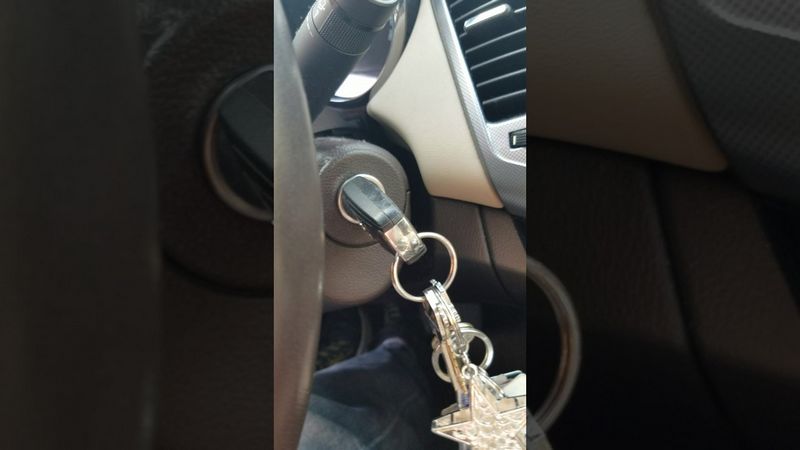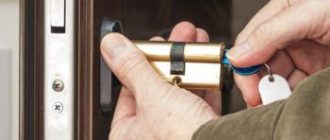
How to get a stuck key out of the lock
Getting a key stuck in a lock can be a frustrating experience. Whether it’s a jammed front door lock or a stubborn padlock, trying to extract a stuck key can feel like an impossible task. However, with a few simple steps and a little patience, you can easily get the key out without damaging the lock.
The first step to remove a stuck key from a lock is to stay calm and avoid panicking. Panicking might cause you to apply excessive force, which can break the key or damage the lock further. Take a deep breath and follow these expert tips to safely retrieve the key.
One of the simplest techniques to free a stuck key is to use lubrication. Apply a small amount of lubricant, such as graphite powder or spray, into the keyhole. This will help loosen any debris or rust that may be causing the key to stick. Gently wiggle the key back and forth while applying slight pressure to see if it starts to come out.
If lubrication doesn’t work, you can try using a pair of needle-nose pliers or tweezers to grip the key and pull it out. Make sure you have a good grip and pull straight out without tilting or twisting the key. Be careful not to use too much force, as you could break the key or damage the lock.
If the key is still stuck, you may need to resort to using a key extractor tool. These tools are specifically designed to remove stuck keys and are available at most hardware stores. Insert the key extractor into the keyway, turn it slightly, and then slowly pull it out while applying gentle pressure.
When all else fails, it’s best to call a professional locksmith. Locksmiths have the experience and specialized tools to handle stuck keys and difficult lock situations. They can safely remove the key without causing any further damage to the lock and can also provide advice on how to prevent future incidents.
Remember, removing a stuck key requires patience and caution. Avoid using excessive force, as it can cause more harm than good. By following these simple steps, you can safely and effectively get a stuck key out of a lock without having to call a locksmith.
Assess the Situation
Before trying to remove a stuck key from a lock, it is important to assess the situation to determine the best course of action. Start by carefully examining the key and the lock to identify any visible obstacles or damage that may be causing the key to be stuck.
Look for any debris or foreign objects that may have become lodged in the lock, such as dirt or pieces of broken key. These obstructions can prevent the key from sliding in or out smoothly. If you notice any visible debris, try to gently remove it using a pair of tweezers or a small tool.
Additionally, check the condition of the key itself. Look for signs of wear and tear, such as bent or damaged key teeth. If the key is in poor condition, it may be more difficult to remove and may require professional assistance.
It is also important to consider the type of lock you are dealing with. Different types of locks may require different techniques to remove a stuck key. For example, a pin tumbler lock may need to be lubricated before attempting to remove the key, while a wafer tumbler lock may require a different approach.
By assessing the situation, you can determine how to proceed and avoid causing further damage to the lock or key. Remember to proceed with caution and be patient in your efforts to get the stuck key out of the lock.
Lubricate the Lock
To remove a stuck key from a lock, lubrication is the key. It can help to loosen any debris or dirt that may be causing the key to be stuck.
Here’s how to lubricate the lock:
- Choose a lubricant suitable for locks. WD-40 or graphite lubricant are commonly used.
- Apply a small amount of the lubricant to the key and insert it into the lock.
- Jiggle the key gently while applying slight pressure to help distribute the lubricant throughout the lock mechanism.
- Remove the key and wipe off any excess lubricant.
- Repeat the process if the key is still stuck, and consider seeking professional help if the issue persists.
Remember, regular maintenance and lubrication can help prevent keys from getting stuck in locks in the future.
Try Jiggling and Wiggling
One of the first and simplest methods to try when you have a stuck key is to jiggle and wiggle it. Sometimes a key gets stuck because it is not aligned correctly with the lock mechanism. By gently jiggling and wiggling the key, you may be able to loosen it and get it out of the lock.
Here’s how to jiggle and wiggle a stuck key:
| 1. | Hold onto the key firmly with your thumb and index finger. |
| 2. | Gently insert the key fully into the lock. |
| 3. | While applying slight pressure, start jiggling the key side to side. |
| 4. | Next, try wiggling the key up and down while still applying pressure. |
| 5. | Continue jiggling and wiggling the key for a few minutes to see if it starts to loosen. |
If the key remains stuck after trying this method, don’t force it as it could break off in the lock. Move on to the next step to try a different approach.
Use a Key Extractor Tool
If the key is still stuck and none of the previous steps have worked to get it out, you may need to use a key extractor tool. This tool is specifically designed to help remove stuck keys from locks.
To use a key extractor tool, follow these steps:
| 1 | Select a key extractor tool that matches the size and shape of the key stuck in the lock. |
| 2 | Insert the key extractor tool into the lock alongside the stuck key. |
| 3 | Apply gentle pressure to the key extractor tool to push it further into the lock. |
| 4 | Slowly turn the key extractor tool in the same direction you would turn the key to unlock the lock. |
| 5 | Continue turning the key extractor tool until the stuck key comes out of the lock. |
Using a key extractor tool can be an effective method to remove a stuck key from a lock. However, if you do not have a key extractor tool or are unable to remove the key using this method, it is recommended to call a professional locksmith for assistance.
Seek Professional Help
If you have tried all the previous steps and are still not able to get the stuck key out of the lock, it may be time to seek professional assistance. Professional locksmiths have the experience and tools necessary to handle even the most stubborn stuck keys. They can easily remove the key without causing any damage to the lock.
Attempting to force the key out on your own could lead to further complications and potentially damage the lock mechanism or key itself. Calling a professional locksmith will not only save you time and frustration but also ensure that the job is done correctly and safely.
When contacting a locksmith, be sure to explain the situation clearly and provide any relevant details about the lock and key. This will help them come prepared with the appropriate tools and techniques for the job.
Remember, seeking professional help is the best course of action when dealing with a stuck key that won’t budge.
Avoid Using Excessive Force
When a key gets stuck in a lock, our initial reaction is often to use brute force to try and get it out. However, this is one of the worst things you can do! Applying excessive force can not only damage the lock further but also break the key, making the situation much worse.
Instead of using excessive force, there are some alternative methods you can try to gently remove the stuck key. Here’s how:
- First, remain calm and take a deep breath. Panicking will only make it more difficult to solve the problem.
- Before trying anything, lubricate the lock with a small amount of graphite powder or silicone spray. This will help reduce friction and make it easier for the key to slide out.
- Next, try jiggling the key gently while pulling it out. Sometimes, the key can get stuck due to misalignment, and a little movement can free it up.
- If jiggling doesn’t work, you can try using a pair of needle-nose pliers or tweezers to grip the key and pull it out slowly. Be careful not to apply too much pressure to avoid breaking the key.
- If all else fails, it’s time to call a professional locksmith. They have the skills and tools necessary to safely and efficiently remove the stuck key without causing any further damage.
Remember, patience is key when dealing with a stuck key. By following these simple steps and avoiding excessive force, you can increase your chances of removing the key successfully without causing any additional problems.
Use a Hammer and Screwdriver
If you’ve tried all the previous methods and still can’t get the key out of the lock, you can try using a hammer and screwdriver. This method should be used as a last resort, as it can potentially cause damage to the lock or key.
To use this method, start by placing the screwdriver into the keyhole and turning it counterclockwise to loosen the key. Next, take a small hammer and gently tap the screwdriver to further loosen the key. Be careful not to hit the lock or apply too much force, as this can cause the key to break.
After tapping the screwdriver a few times, try pulling the key out of the lock. If it still doesn’t budge, you can continue tapping the screwdriver with the hammer until the key loosens enough to be removed. If the key does break during this process, you may need to call a professional locksmith to remove the broken key and repair the lock.
Remember, using a hammer and screwdriver to remove a stuck key should only be done as a last resort. It’s always best to try the less invasive methods first, such as using lubricant or jiggling the key gently. If none of these methods work, then you can consider using a hammer and screwdriver, but exercise caution to avoid causing any further damage.
Apply Graphite Powder
If the key is stuck and you can’t get it out of the lock, using graphite powder can often help to loosen it. Graphite powder is a fine lubricant that can reduce friction between the key and the lock mechanism.
To apply graphite powder, simply insert the key into the lock and then remove it. Tap the end of the key lightly to dislodge any excess graphite powder. Then, insert the key into the lock again and wiggle it gently to distribute the powder throughout the lock mechanism.
After applying the graphite powder, try to turn the key gently to see if it helps to free it. If the key still doesn’t turn, you may need to repeat the process a few more times to fully eliminate any stuck debris or friction. It’s important not to use too much graphite powder, as it can cake up and make the situation worse.
Remember to clean up any excess graphite powder after using it, as it can be messy and stain surfaces. You can use a soft cloth or a small brush to remove any residue.
Use a pair of Needle-Nose Pliers
If you’ve tried all the previous methods and still can’t get the stuck key out of the lock, it’s time to bring out the big guns. A pair of needle-nose pliers may be just what you need to remove the key.
Here’s how to use the pliers to get the key out:
| Step 1: | Open the pliers and position them around the key, as close to the lock as possible. |
| Step 2: | Gently squeeze the pliers to get a good grip on the key. |
| Step 3: | Try to gently pull the key straight out of the lock. Be careful not to use too much force, as this could cause the key to break. |
| Step 4: | If the key doesn’t come out easily, try wiggling it slightly while pulling. This can help loosen it from the stuck position. |
| Step 5: | If all else fails, you may need to consult a professional locksmith to remove the key. |
Remember, using needle-nose pliers to remove a stuck key should be your last resort. If you’re not confident in your ability to do so safely, it’s best to seek professional help.
Heat the Lock with a Hairdryer
If you’ve tried pulling, wiggling, or jiggling the key out of the lock and it’s still stuck, using heat can be an effective method to loosen it up. One way to do this is by using a hairdryer. Here’s how:
| Step 1: | Plug in the hairdryer and set it to the highest heat setting. |
| Step 2: | Aim the nozzle of the hairdryer at the lock, making sure it’s close enough to generate heat without touching the lock. |
| Step 3: | Turn on the hairdryer and apply the heat to the lock for about a minute or two. |
| Step 4: | After heating the lock, quickly try to remove the key by gently pulling or wiggling it. |
| Step 5: | If the key is still stuck, repeat the process of heating the lock and try again. |
Remember to be cautious when using heat near a lock, as excessive heat can damage the lock mechanism. If the key remains stuck after attempting these steps, it’s recommended to seek the assistance of a professional locksmith to avoid further damage.
Clean the Lock Mechanism
If the key is stuck in the lock, one possible reason could be dirt or debris inside the lock mechanism. To get the key out, you will need to clean the lock’s interior. Here’s how:
- Start by spraying a small amount of lubricant, such as WD-40, into the keyhole. This will help loosen any stuck components.
- Next, use a thin, pointed object like a toothpick or a needle to carefully remove any visible dirt or debris from the lock. Be gentle to avoid causing further damage.
- If the key is still stuck, you can try using a graphite lubricant to further loosen the mechanism. Apply a small amount directly onto the key and insert it into the lock, gently turning it back and forth to distribute the lubricant.
- After lubricating the lock, use a clean, dry cloth to wipe away any excess lubricant. This will prevent it from attracting more dirt or debris.
- Finally, test the lock by inserting the key and turning it. If it still doesn’t turn smoothly, repeat the cleaning process or consider calling a locksmith for assistance.
By cleaning the lock mechanism, you can increase the chances of successfully removing a stuck key. However, if you are unsure or uncomfortable with attempting the process yourself, it’s always best to seek professional help to avoid causing further damage to the lock or key.
Tap the Lock Gently
Another simple method to try when a key is stuck in a lock is to tap the lock gently. This can help to loosen the key and make it easier to remove.
Here’s how to do it:
| 1. | Hold the key firmly with one hand. |
| 2. | Tap the lock gently with your other hand. |
| 3. | Try to turn the key and see if it comes out. |
Be careful not to tap the lock too hard, as this could damage the lock or the key. Start with gentle taps and increase the force if necessary, but always be cautious.
Remember, it’s important to be patient and not rush when trying to get a stuck key out of a lock. Trying to force the key out can cause more damage and make the situation worse. If these simple methods don’t work, it’s best to call a professional locksmith for assistance.
Remove the Lock Cylinder
If the key is stuck and can’t be easily removed from the lock, you may need to remove the lock cylinder. Here’s how you can do it:
Step 1: Determine the type of lock cylinder
Before you can remove the lock cylinder, you need to determine what type of lock you have. There are different types of lock cylinders, such as pin tumbler locks, wafer locks, and tubular locks. Understanding the type of lock you’re dealing with will help you identify the right method to remove it.
Step 2: Gather the necessary tools
Once you know the type of lock cylinder, gather the necessary tools to safely remove it. This may include a screwdriver, a key extractor, needle-nose pliers, or a lock removal tool. Make sure you have all the tools on hand before proceeding with the removal process.
Step 3: Remove the lock cover or faceplate
Some locks have a cover or faceplate that needs to be removed before you can access the lock cylinder. Use a screwdriver to remove any screws holding the cover or faceplate in place. Once removed, set them aside in a safe place.
Step 4: Extract the lock cylinder
With the cover or faceplate removed, you can now access the lock cylinder. Depending on the lock type, you may need to use a key extractor, needle-nose pliers, or a lock removal tool to carefully extract the cylinder. Be gentle and take your time to avoid damaging the lock or the key.
Step 5: Get the stuck key out
Once the lock cylinder is removed, you can easily get the stuck key out. Use your fingers or a pair of needle-nose pliers to grip the key and pull it out of the lock. Ensure that you remove the key completely and check the lock cylinder for any debris or obstruction that may have caused the key to get stuck.
By following these simple steps, you can effectively remove a stuck key from a lock by removing the lock cylinder. Remember to always handle locks and keys with care to avoid further damage.
Seek Assistance from a Locksmith
If you have tried all the techniques mentioned above and the key is still stuck in the lock, it is time to seek professional help. A locksmith is a trained expert who can assist you in removing the key safely without causing any damage to the lock or the key itself. Locksmiths have specialized tools and knowledge of lock mechanisms, making them the best option to handle such situations.
When contacting a locksmith, provide them with a detailed explanation of the problem and the steps you have already taken to try to remove the key. This information will help them understand the situation better and come prepared with the necessary tools and solutions.
It is important to choose a reliable and experienced locksmith to ensure that the problem is resolved efficiently. Look for locksmiths with positive reviews and recommendations from trusted sources. You can also request quotes from different locksmiths to compare their prices and services before making a decision.
Remember, trying to force the key out or using excessive pressure can lead to further damage to the lock, making the situation more complicated and expensive to fix. Therefore, it is crucial to rely on the expertise of a locksmith to get the key out of the lock safely and professionally.
Key takeaways:
- Seek assistance from a locksmith if the key is still stuck in the lock after trying all the recommended techniques.
- Provide the locksmith with a detailed explanation of the problem and the steps you have already taken.
- Choose a reliable and experienced locksmith by considering their reviews and recommendations.
- Forcing the key or using excessive pressure can cause further damage to the lock.
By following these steps, you will be able to get the stuck key out of the lock safely and efficiently with the help of a professional locksmith.
Prevent Future Key Sticking Issues
To avoid getting a key stuck in the lock in the first place, follow these simple steps:
- Make sure the key is clean and free of debris before inserting it into the lock.
- Avoid inserting the key at an angle, as this can cause it to stick.
- Regularly lubricate the lock with graphite or silicone spray to keep it operating smoothly.
- If the lock feels stiff or difficult to turn, avoid forcing it and instead get a locksmith to fix it.
- Consider using a key retrieval tool or a magnetic key holder to prevent the key from getting stuck in the lock.
By taking these preventative measures, you can avoid the frustration and inconvenience of dealing with a stuck key and keep your locks functioning properly.
Q&A:
How much does it cost to hire a professional locksmith to remove a stuck key?
The cost of hiring a professional locksmith to remove a stuck key can vary depending on several factors, such as the complexity of the lock, the location, and the time of day. On average, you can expect to pay between $75 and $250 for this service. It’s best to contact a few locksmiths in your area to get an accurate quote.
What should I do if my key is stuck in a lock?
If your key is stuck in a lock, there are a few steps you can take to try and remove it. First, make sure the key is inserted fully into the lock and not at an angle. Then, try wiggling the key gently while applying slight pressure to see if it will come out. If these steps don’t work, you can try using lubricant, such as WD-40, to loosen the key. If all else fails, it may be best to call a professional locksmith for assistance.







